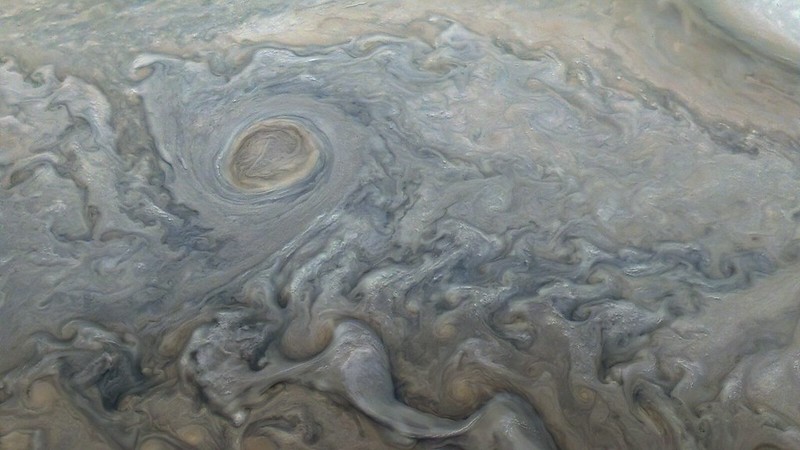The images from perijove 28 are now available. This is image PJ28_24 in approximately true color/contrast and enhanced versions:
Click to view attachmentClick to view attachmentClick to view attachment
Click to view attachmentClick to view attachmentClick to view attachment
Image 28_24 was obtained shortly before Juno's perijove which makes it a very high resolution image. The resolution is highest (slightly better than 3 km/pixel) in the top center area in the 'central' image (the biggest image). At this high resolution some of the cloud features look rather fuzzy.
Full Version: Juno perijove 28
First attempts at maps and composites of PJ28 imagery:

Jupiter - PJ28-21 - Detail

Jupiter - PJ28-21/22 - Detail Map

Jupiter - Perijove 28 - Composite - 1
I've made some great strides improving my pipeline. I'm using some dark fields generated by Bjorn (Thanks!) and fixed a bug that compressed the images in an ugly way. Also, I'm getting good results integrating Denoise AI and Sharpen AI from Topaz Labs into my process. Not sure which one works the best yet, but both are really good. I'll continue uploading most of my intermediate files such as maps, meshes, Blender files, etc to my Google Drive: https://drive.google.com/drive/folders/1mWW...j_L?usp=sharing

Jupiter - PJ28-21 - Detail

Jupiter - PJ28-21/22 - Detail Map

Jupiter - Perijove 28 - Composite - 1
I've made some great strides improving my pipeline. I'm using some dark fields generated by Bjorn (Thanks!) and fixed a bug that compressed the images in an ugly way. Also, I'm getting good results integrating Denoise AI and Sharpen AI from Topaz Labs into my process. Not sure which one works the best yet, but both are really good. I'll continue uploading most of my intermediate files such as maps, meshes, Blender files, etc to my Google Drive: https://drive.google.com/drive/folders/1mWW...j_L?usp=sharing
...Also, I'm getting good results integrating Denoise AI and Sharpen AI from Topaz Labs into my process. Not sure which one works the best yet, but both are really good.
These have now become a 'standard' part of my processing pipeline as well, especially Denoise AI. Usually the results are great (much better than in e.g. Photoshop) but interestingly, I had difficulty getting results I was happy with from Denoise AI when processing image PJ28_24 (posted at the start of this thread). The problem seems to be that this image has a significant amount of relatively fuzzy cloud features plus some low contrast areas, especially where the resolution is highest near top center in the 'central' image in my post. I ended up not using Denoise for this particular image.
My approach was to average the results from multiple upscalers/denoisers by masking and blending between them. It was labor intensive since the process had to be dialed in separately for each frame.
Our amazing Gerald Eichstädt has spotted some lightning on Jupiter!
https://www.missionjuno.swri.edu/junocam/processing?id=9054
https://www.missionjuno.swri.edu/junocam/processing?id=9054
Not a lot of detail there - can we be sure these aren't cosmic ray hits, eg?
Not a lot of detail there - can we be sure these aren't cosmic ray hits, eg?
We can't be sure, but they're generally consistent with point sources (there are four pixels with values above background), whereas cosmics tend to either one pixel or many pixels in a line.
See https://www.storm-t.iag.usp.br/pub/ACA0330/...leo-jupiter.pdf especially Figure 5.
Yeah, PSF-like does suggest a real source.
Unless I've missed this somewhere, these were imaged on PJ28? So presumably day side? I recall the nightside Galileo observations, but are lightning strikes expected to be visible on the day side?
Unless I've missed this somewhere, these were imaged on PJ28? So presumably day side? I recall the nightside Galileo observations, but are lightning strikes expected to be visible on the day side?
Thanks for the details. Any sense of whether these flashes are comparable in brightness to flashes seen by Galileo?
Any sense of whether these flashes are comparable in brightness to flashes seen by Galileo?
It's fairly hard to say. Galileo was taking long time exposures (tens of seconds long, IIRC) and we are taking much shorter exposures with TDI where the flash presumably only lasts as long as one pixel residence time. I guess if you assumed the flash duration was similar one could back out the relative radiometry, but I haven't done that.
No, night side, during the high-TDI departure imaging.
Has any consideration been given to capturing long exposures with TDI disabled
(or intentionally mismatched to spin rate) to elongate or separate flashes?
I see in the GALILEO LIGHTNING paper, they did some "scanned" frames.
Has any consideration been given to capturing long exposures with TDI disabled
(or intentionally mismatched to spin rate) to elongate or separate flashes?
(or intentionally mismatched to spin rate) to elongate or separate flashes?
That's an interesting suggestion, we could look at that. Frankly, Junocam is not the best instrument on the spacecraft to be looking at lightning. We only take these images because the orbit geometry doesn't allow anything else and it's a way to keep the downlink full.
Not a lot of detail there - can we be sure these aren't cosmic ray hits, eg?
Maybe I should provide links to the maps the gif is derived from.
Here the RGB maps.
And here for a closer inspection selected green images for lightning search.
Specifically, #87, and #90.
There are only very few energetic particle hits in those images. And the lightning candidates are located at FFRs, where lightnings would be plausible or expected.
So, besides the structure of the spots, the location hints towards lightning on a probabilistic basis.
In the lower third of this site, you'll find less processed drafts to look for possible energetic particle hits and for stars to compare them with lightning candidates.
This is a "lo-fi" version of our main content. To view the full version with more information, formatting and images, please click here.
